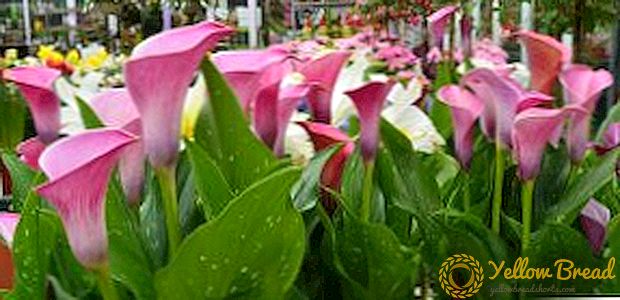 Raspberries - The favorite berry culture of many gardeners. Juicy berries are appreciated not only for excellent taste, but also famous for their useful properties. The fruits of the plant have an anti-inflammatory, antipyretic effect, increase the tone of the body and give energy, help to fight stress. However, for successful cultivation, you need to know how to effectively resist raspberry pests.
Raspberries - The favorite berry culture of many gardeners. Juicy berries are appreciated not only for excellent taste, but also famous for their useful properties. The fruits of the plant have an anti-inflammatory, antipyretic effect, increase the tone of the body and give energy, help to fight stress. However, for successful cultivation, you need to know how to effectively resist raspberry pests.
- Galliches
- Shootgall
- Raspberry stem gallitsa
- Strawberry raspberry weevil
- Pliers
- Spider mite
- Raspberry mite
- Raspberry beetle
- Raspberry bud moth
- Raspberry nutcake
- Raspberry fly stem
- Raspberry glass bowl
- Raspberry leaf aphid
- Pest prevention
Galliches
Shootgall
The raspberry gall midge (raspberry mosquito) is the most dangerous pest of this crop. In the spring, insects lay eggs in crevices on the bark of the plant. From them larvae of white color develop. Eating, the larvae emit toxic substances that cause the formation of galls - swelling, and the bark cracks strongly.
 The growth of raspberries due to damage slows down, shoots dry out and break when strong gusts of wind. Over time, the larvae fall to the ground, wrapped in cocoons and grow into adult insects. For one season can go through three cycles of pest development.
The growth of raspberries due to damage slows down, shoots dry out and break when strong gusts of wind. Over time, the larvae fall to the ground, wrapped in cocoons and grow into adult insects. For one season can go through three cycles of pest development.
To fight it, it is necessary in the summer, when most of the larvae are, to destroy infected shoots. It is also recommended to spray the soil under the bushes with a 0.15-0.3% solution of chlorophos twice. The first time this is done when the soil is heated to +13 ° C, before the departure of insects, again - 10 days after the first spraying.
Raspberry stem gallitsa
A small fly in May-June lays eggs near the raspberry buds. The hatched larvae begin to feed on the sap of the plant, disrupting its normal development. In places of accumulation of larvae galls are formed. Where these seals appear, the bark cracks and separates from the branch. The larvae pupate directly in the gall and the cycle continues.
The fight with stem gallfly on raspberries occurs with the help of:
- scrupulous selection of planting material, without signs of infection;
- thorough destruction of all damaged branches;
- spraying raspberries with chemicals twice a year (in spring, before the laying of insects and eggs in the fall, after harvesting and digging the soil). To do this, use 1% Bordeaux liquid or an emulsion of karbofos (0.1-0.2%).
Strawberry raspberry weevil
 With the arrival of the first spring heat, the immature beetles begin to eat the young leaves of the raspberry, and with the advent of buds, the anthers from the flowers. Then the female lays the eggs in the bud, gnaws it, and the further development of the pest takes place in the fallen inflorescence.
With the arrival of the first spring heat, the immature beetles begin to eat the young leaves of the raspberry, and with the advent of buds, the anthers from the flowers. Then the female lays the eggs in the bud, gnaws it, and the further development of the pest takes place in the fallen inflorescence.
The larva feeds on a bud, pupates and eventually turns into an adult insect. The cycle is repeated. Infection with strawberry-raspberry weevil can be identified by small holes on young leaves of raspberry, the fall of buds and the presence of larvae in them.
Experienced gardeners advise the following methods of protecting raspberries from this pest:
- agrotechnical: digging or autumn plowing under the bushes;
- mechanical: destruction of fallen leaves and buds, shaking off beetles from a plant;
- biological: planting strongly smelling plants between raspberry bushes (garlic, onion, tansy, celandine, mustard, chilli pepper, etc.);
- chemical: spraying a plant before and after flowering with Fufafon preparations (15 ml of the substance dissolved in 5 l of water; consumption - 5 l of solution per 10 m²), Kemifos (10 ml of the preparation is added to 10 l of water; consumption - 1.5 l of solution per 10 m²), Alatar (5 ml of the drug is dissolved in 4 liters of water; consumption - 4 liters of solution per 100 m²).
Pliers
Spider mite
 This pest can attack raspberries in dry and hot weather. He lives on the underside of the leaves and entangles them with cobwebs. It feeds on plant sap. As a result of infection on the leaves appear white spots, and over time they dry out completely. With a tick on raspberries, you can fight in the following ways:
This pest can attack raspberries in dry and hot weather. He lives on the underside of the leaves and entangles them with cobwebs. It feeds on plant sap. As a result of infection on the leaves appear white spots, and over time they dry out completely. With a tick on raspberries, you can fight in the following ways:
- applying watering bushes and soil beneath them in hot weather;
- sprinkling the plant according to the instructions using such preparations as colloidal sulfur, karbofos, cydial, phosphamide, metaphos. If necessary, the processing of chemicals is repeated several times, with an interval of 10 days.
Raspberry mite
Female pests overwinter under the upper shell of the kidney. During the leafing period, the mites exit the cover and begin to feed on the sap of the plant. The leaves at the same time bend and brighten, the bushes grow poorly.
For the prevention of infection and control of raspberry mites, after flowering and harvest, it is recommended to spray the plant with karbofos. Insecticides "Aktellik", "Fufafon", "Iskra M" are used.
Raspberry beetle
 Insect winters at a depth of 5-10 cm in the soil. In spring she climbs up on the blossoming flowers of raspberry, lays eggs from which larvae develop, and eats buds. The larvae return to the ground to pupate and turn into adult insects next spring. The cycle is repeated.
Insect winters at a depth of 5-10 cm in the soil. In spring she climbs up on the blossoming flowers of raspberry, lays eggs from which larvae develop, and eats buds. The larvae return to the ground to pupate and turn into adult insects next spring. The cycle is repeated.
In the war with the raspberry beetle, the following methods of struggle are used:
- digging up the soil under the plants and between the rows during the formation of insect pupae;
- spraying with decis, konfidor, karbofos.
Raspberry bud moth
Special harm causes early varieties of raspberries. Caterpillars hibernate in cracks on the bark of shoots or under plants in fallen leaves. In the spring, they gnaw out the buds of the plant and pupate there.Dark brown butterflies appear from the pupae and lay eggs in flowers. Hatched caterpillars eat ripe berries
To get rid of the raspberry bud moth, you must:
- when pruning old branches to ensure that there is no stumps left;
- as soon as the kidneys begin to swell, process the raspberry jam "Iskra", "Confidor", "Decis" or "Malathion".
Raspberry nutcake

Pest larvae, feeding on sap from raspberry stalks, cause cracking and swelling of the bark. Damaged branches poorly bear fruit, break and dry. It differs from stem gall midges only in the size of seals, which can reach up to 10 cm in length. Apply the same control measures as previous pests.
Raspberry fly stem
LThe insect's egg gnaws spiral-shaped holes inside the stem, causing the tops of the raspberry to quickly wilt and turn black, and then rot. At the beginning of flowering, the larvae leave for wintering in the soil, where they turn into butterflies, which lay eggs. Hatching caterpillars begin to re-spoil the branches from the inside.
In the case of the raspberry stem fly, the following control methods are used:
- digging up the soil in autumn and cleaning fallen leaves;
- processing of culture in early spring (as soon as young shoots appear), with the help of "Karbofos" or "Aktelliki".
Raspberry glass bowl
 In the middle of summer, butterflies lay eggs on the soil at the base of raspberry shoots. White caterpillars that appear from them begin to bite into the branches, because of which bulges appear. They hibernate and pupate right in the stems of the plant. The following year, the pupae turn into butterflies and the cycle repeats. A raspberry infested with a glass dish quickly fades and dries.
In the middle of summer, butterflies lay eggs on the soil at the base of raspberry shoots. White caterpillars that appear from them begin to bite into the branches, because of which bulges appear. They hibernate and pupate right in the stems of the plant. The following year, the pupae turn into butterflies and the cycle repeats. A raspberry infested with a glass dish quickly fades and dries.
To prevent the pest from multiplying, it is necessary to destroy damaged shoots as soon as possible, and remove old branches without leaving hemp.
Raspberry leaf aphid
The insect lives on the underside of raspberry leaves in small colonies. It feeds on sap from plant stems and can tolerate viral diseases. Due to the defeat of aphids, raspberries grow poorly and eventually dries out. The main way of dealing with a pest is the treatment of "Aktellik" or "Karbofos" during the blooming of the kidneys.
Pest prevention
 Before you get a good harvest, it is necessary to spray raspberries in the spring against pests. For this, it is recommended to use modern drugs. (for example, the same "Aktellik" or "Karbofos") . Treatment with chemicals, if necessary, is repeated several times per season. If you combine this process with a periodic inspection of the bushes and in time to destroy the affected shoots, then you can count on an abundance of berries. Also, it would be useful to dig the soil after harvest.
Before you get a good harvest, it is necessary to spray raspberries in the spring against pests. For this, it is recommended to use modern drugs. (for example, the same "Aktellik" or "Karbofos") . Treatment with chemicals, if necessary, is repeated several times per season. If you combine this process with a periodic inspection of the bushes and in time to destroy the affected shoots, then you can count on an abundance of berries. Also, it would be useful to dig the soil after harvest.






